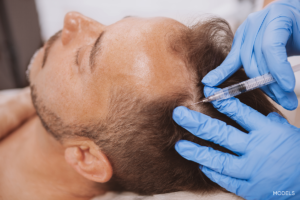Hair Loss
Hair loss, or alopecia, can be frustrating for kids, teens and adults alike. To add to the frustration, there are many different reasons for hair loss, leading to different management and expectations for regrowth. A visit to your California Skin Institute board-certified dermatologist can help properly diagnose what type of hair loss you are experiencing as well as tailor a treatment regimen just for you. Sometimes, a biopsy is performed to confirm the diagnosis. This involves numbing the skin, using a cookie cutter shaped device to remove a small piece of the skin, and sealing the area with a few stitches that are generally removed in 10-14 days. Typical recommendations for all types of hair loss include taking a vitamin supplement containing biotin, using a thickening shampoo, and refraining from aggressive heat styling processes.
Sometimes, hair loss can present as excess shedding of the hair, called telogen effluvium. We all typically lose 100-150 hairs daily as part of the natural life cycle of the hair follicle. When a shift occurs so that more hairs than usual are shed (more on the order of 300 hairs daily), you get telogen effluvium. It commonly occurs 3 months or so after a stressor, hospitalization, severe illness, severe weight loss or abrupt hormonal shift and tends to improve with time.
 Male and female pattern hair loss are typical changes to the hair that happen as we get older, though many can begin to experience this thinning in their 20s or even teenage years. Classic male pattern hair loss (MPHL) begins with thinning of the hairline at the temples and on the top of the scalp. Classic female pattern hair loss (FPHL) causes thinning of the midline of the scalp, or a widened hair part. Various medications can help slow this process, though the hair loss may progress.
Male and female pattern hair loss are typical changes to the hair that happen as we get older, though many can begin to experience this thinning in their 20s or even teenage years. Classic male pattern hair loss (MPHL) begins with thinning of the hairline at the temples and on the top of the scalp. Classic female pattern hair loss (FPHL) causes thinning of the midline of the scalp, or a widened hair part. Various medications can help slow this process, though the hair loss may progress.
Topical medicines that have minoxidil in them, can improve hair loss. We speculate that this medicine may improve the blood flow to the treated areas, leading to improved growth. Finasteride is classically used for MPHL in the form of a daily oral pill. There have been some concerning reports of sexual side effects with this medicine, with 1.4% of men experiencing permanent sexual side effects. Thus, this medication, while very efficacious, should be taken with caution. For women, using an anti-male hormone medicine, like spironolactone, may be helpful for hair loss. For both genders, use of a low-level light laser device, such as the HairMax, may be helpful.
 Newer treatments have also shown favor, such as PRP therapy. PRP treatments involve taking a sample of your blood, spinning it down using a centrifuge, then extracting a portion containing proteins important in growth and injecting it into the area of hair loss. This process is repeated monthly for usually 3-4 sessions, followed by a maintenance regimen. Your board-certified CSI dermatologist can determine if PRP might be right for you.
Newer treatments have also shown favor, such as PRP therapy. PRP treatments involve taking a sample of your blood, spinning it down using a centrifuge, then extracting a portion containing proteins important in growth and injecting it into the area of hair loss. This process is repeated monthly for usually 3-4 sessions, followed by a maintenance regimen. Your board-certified CSI dermatologist can determine if PRP might be right for you.
Traction alopecia comes from the hair being repetitively pulled or stressed, usually from certain hairstyles. For example, tight buns and ponytails or braids can lead to thinning and actual hair loss over time. Even regular use of extensions can have a similar effect. This form of hair loss can be reversed if hair care methods are changed early on with decreased heat styling, gentle protective hair styles and regular variations in hair style.
Alopecia areata typically presents with coin-shaped areas of complete hair loss on the scalp, though can also appear on the eyelashes, eyebrows, facial hair and body hair. This is an autoimmune condition, which means that the immune system actually attacks the hair follicles. This condition can be very challenging given how variable one’s course can be. There are some people who will only have one episode of alopecia areata, perhaps triggered by stress, that will self-resolve; while others may have multiple episodes of alopecia that don’t respond to typical medicines and may continue to involve hair loss of the entire scalp. A new class of medicines that attack a focal part of the immune system are showing extreme promise for alopecia areata.
Sometimes, extreme inflammation from dandruff, eczema or psoriasis can lead to hair loss. This tends to be reversible if the inflammation is treated. Taking a multi-step approach with the use of medicated shampoos and topical corticosteroids is typically helpful in improving the condition, with some patients requiring a maintenance plan to help preserve their results.
Lastly, there are some types of hair loss that are scarring and permanent. Evaluation by your California Skin Institute board-certified dermatologist is important for early diagnosis and intervention to hopefully stop the hair loss.

 / 291 Reviews
/ 291 Reviews